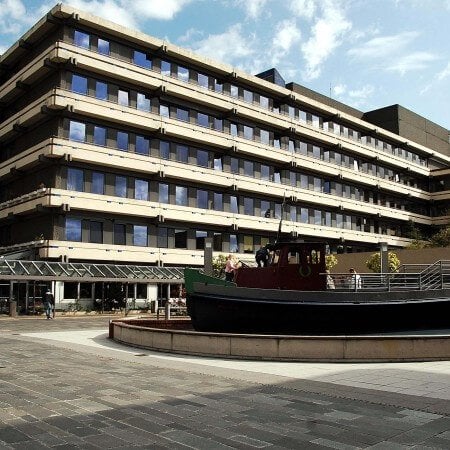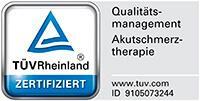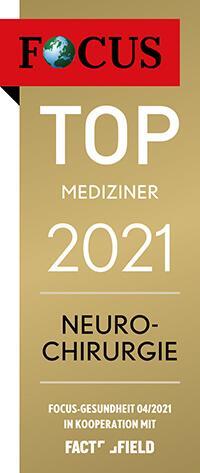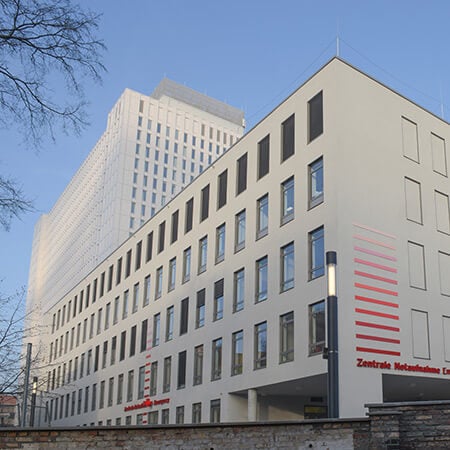Brain aneurysm is an abnormal ballooning or expansion of a brain blood vessel.
The most efficient treatment is the surgical one, i.e. resection, coiling and clipping.
The cost of partial resection and coiling starts at €9,825, the cost of treatment with surgical clipping starts at €8,606. You can find other prices on the Booking Health website.
The best hospitals in Europe are:
| Hospital | Country, city |
|---|
| Sana Hospital Duisburg | Germany, Duisburg |
| Charite University Hospital Berlin | Germany, Berlin |
| University Hospital Freiburg | Germany, Freiburg |
| University Hospital Frankfurt-am-Main | Germany, Frankfurt-am-Main |
| University Hospital Erlangen | Germany, Erlangen |
Brain aneurysms are local enlargements of blood vessels. They look like a bag-shaped bulge. The wall in this place is weakened, and therefore aneurysm ruptures with hemorrhage into the subarachnoid space of the brain often occur. The risk of this complication increases with a lesion larger than 7 mm. Doctors in Europe perform endovascular procedures and microsurgical interventions to cut off the blood flow through the aneurysm. Thanks to experienced doctors and high-quality equipment, the effectiveness of treatment abroad exceeds 90%, and the risk of severe complications is three times lower than the world average.
Content
- How common are aneurysms
- Symptoms of brain aneurysm
- Diagnostics of brain aneurysm
- Do brain aneurysms require treatment
- Endovascular treatment of aneurysm
- Surgical treatment of brain aneurysm
- Where is it better to undergo treatment for brain aneurysms
- Treatment in Europe at an affordable price
How common are aneurysms
Previously, the prevalence of brain aneurysms was judged solely by the number of subarachnoid hemorrhages that occurred as a result of their rupture. No asymptomatic vascular bulging was found. The frequency of ruptures is 10-15 cases per 100,000 population per year.
Today we have information about the prevalence of asymptomatic brain aneurysms. The disease affects approximately 2.8% of people. They are more common in women than in men, and are found predominantly in the age group over 30. 15-30% of patients have more than one aneurysm.
Risk factors:
- Arterial hypertension.
- Family history of brain aneurysms.
- Concomitant brain diseases.
- Hormone replacement therapy in postmenopausal women.
The frequency of familial aneurysms in cerebral arteries is 7-20%.
Symptoms of brain aneurysm
The brain aneurysm that has not yet ruptured usually causes no symptoms.
The ruptured brain aneurysm causes hemorrhage. Blood accumulates in the subarachnoid space. The rupture results in the impaired blood supply to the brain, and a section of brain tissue often dies off. This condition is considered a hemorrhagic stroke. It is severe, poses a high risk of death and disability. If the person survives, they need surgery to prevent repeated hemorrhage.
Brain aneurysms can rarely cause symptoms. The symptomatic course is typical only for giant formations. They compress the structures of the brain due to the abnormal intracranial pressure. The clinical course of such aneurysms is called pseudotumorous, since they imitate a tumor. The pathology may cause transient ischemic brain disorders: a person may have impaired limb mobility, difficulty speaking, swallowing disorders or other focal symptoms, depending on the artery in which the aneurysm is located.
With giant bulging of blood vessels, the risk of rupture is several times higher. This group of patients requires treatment as the preventive measure against brain aneurysm rupture.
Diagnostics of brain aneurysm
In developed countries, the main diagnostic option is MRI. The sensitivity of the diagnostic examination on modern devices for the detection of formations from 5 mm reaches 98%. A more informative diagnostic test involves the use of a contrast agent.
Another accurate diagnostic study is a CT scan. Doctors often use 3D reconstruction of the brain aneurysm to assess the type of blood supply and plan treatment. Nonetheless, the CT scan has a drawback: radiation exposure. Therefore, the method is not usually used repeatedly to monitor asymptomatic patients.
X-ray angiography is rarely used in developed countries, but it is still widely used in developing countries. This diagnostic test is informative, but it is invasive: it requires the administration of the contrast agent into the blood by catheterization of the arterial bed. This is the main disadvantage of angiography as compared with CT scans and MRI. With the use of the last ones, the contrast agent can be injected into the venous blood through the median cubital vein.
To undergo angiography, the patient has to be hospitalized, as the procedure can sometimes give complications. In Europe, it is carried out mainly in the presence of contraindications to the use of contrast agents for CT scans and MRI, for example, in case of renal failure. Although the diagnostic test is invasive, it is more accurate than CT scans and MRI for detecting small aneurysms – up to 3 mm.
Do brain aneurysms require treatment
Diagnostic methods are improving, becoming more accurate, and therefore asymptomatic aneurysms, which a person did not even suspect, are increasingly being diagnosed in people in the brain. Do these patients need treatment? On the one hand, there is a risk of rupture of even a small aneurysm, which can result in the extravasation of blood into the brain, death or disability of the patient. On the other hand, most aneurysms never rupture in their lifetime, and surgical treatment itself carries certain risks. Therefore, when deciding on the need for treatment, doctors weigh the potential risks and benefits of medical procedures and neurosurgical interventions.
There are two large studies that have assessed the risk of rupture of asymptomatic brain aneurysms. As a result, the key risk factors for ruptured aneurysm were identified, the presence of which makes doctors decide on the need for treatment.
According to the ISUIA study, risk factors for ruptured brain aneurysm are as follows:
- The size of the formation is more than 7 mm.
- Localization in the vertebrobasilar basin or in the region of the posterior communicating artery.
- A history of subarachnoid hemorrhage.
A Japanese UCAS study found that the risk of ruptured aneurysm is:
- 0.36% per year for brain aneurysms with the size of 3-4 mm;
- 0.5% for formations with the size of 5-6 mm.
- 1.69% with the size of 7-9 mm.
- 4.37% in case of reaching the size from 10 to 24 mm.
- 33.4% with giant brain aneurysms from 25 mm.
The increased risk of rupture is indicated not only by the characteristic localization of the formation, but also by the presence of diverticula (wall protrusions) in it.
The authors noted that the data cannot be applied to the European population, since the Asian race is at higher risk of ruptured brain aneurysm. However, the trends are the same for residents of all countries and continents: the larger the formation, the more likely complications will arise. Accordingly, the more likely it is that the doctor will decide whether to treat such an aneurysm.
The rupture most often occurs when the size of the aneurysm is more than 1 cm. Nonetheless, it is relatively rare. Therefore, in absolute numbers, the amount of ruptured aneurysms less than 1 cm in size is much higher. For example, according to W. Sang, who described 627 ruptures, only 12% of cases were in formation of more than 1 cm, and almost 72% of cases of rupture were in aneurysms less than 7 mm in size. Thus, only formations of 4 mm or less should be considered safe.
Another predictive factor is aneurysm growth. If it increases over the year by 0.75 mm or more, then the risk of rupture during the year is 5.4%. Without any growth tendency observed, the likelihood of this complication is minimal.
Endovascular treatment of aneurysm
The safest treatment option is to remove the aneurysm with access through the blood vessels (endovascular intervention). In this case, doctors do not have to open the patient's skull. Endovascular treatment is the technique of choice for patients with aneurysms of the vertebrobasilar basin and the paraclinoid segment of the internal carotid artery.
To eliminate aneurysms, doctors most often use coiling and clipping techniques. Coils are injected into the aneurysm, after which blood coagulation occurs in this place and blood clots form. They fill the aneurysm and close the entrance to it, thereby stopping the blood flow. The endovascular technique provides better results for narrow-necked aneurysms. If the patient has a wide-necked aneurysm, specialists apply a stent- or balloon-assisted method in order to avoid the coil loops falling out. The techniques used by doctors are as follows:
- Temporary occlusion (closure of the lumen) of the vessel supplying the blood with a balloon catheter.
- Reconstruction of the lumen of the artery with a stent at the level of the neck.
Large, multi-chambered, and diverticular aneurysms are most difficult to treat. In such situations, doctors strive to occlude the main chamber and close the neck as tightly as possible so that no more blood flows into the bulging. If the blood flow inside the aneurysm is stopped, the risk of rupture is reduced to zero. However, some patients have recanalization, which is the restoration of blood flow through the pathological section of the vessel. Therefore, endovascular treatment, although safer, is less reliable than surgery.
Another problem that doctors face is pathological tortuosity, loops and kinks of the arteries. They are detected in 5% of patients. In such situations, foreign experts use guiding catheters.
Thus, endovascular treatment is safer, but less reliable than surgery. On average, its efficiency is 55%. In other patients, either it is not possible to close the aneurysm, or the blood flow through it is restored after some time (recanalization). The best European hospitals use modern technologies in order to achieve a successful and reliable blood flow shutdown through the aneurysm even in the most difficult cases, so the efficiency of manipulations is higher – it reaches 70%. But still, the results are worse than when performing the surgical intervention. Therefore, endovascular treatment is the method of choice for patients over 60 years of age or with concomitant diseases for whom conventional surgery may be unsafe.
Surgical treatment of brain aneurysm
The classic treatment option is surgery. With this approach, mortality and the risk of complications are higher, but the effectiveness of the treatment exceeds 90%. The surgical intervention is preferred in patients under 60 years of age who do not have severe chronic diseases.
The essence of the surgical intervention is that a clip is applied to the brain aneurysm foundation. It separates the formation from the blood vessel, and the blood flow through it stops.
In all hospitals, surgical intervention is effective, but not everywhere it is equally safe. The incidence of complications in different medical facilities ranges from 5 to 30%. To minimize health risks, you can receive medical treatment abroad.
Foreign centers apply high-quality intraoperative control of the procedure. Doctors use neuroimaging techniques to assess the state of blood vessels and brain tissue, to avoid damage to functionally important areas. When working in a narrow and deep wound, endoscopic assistance is used. To imagine the clipping area, doctors insert a thin tube with a video camera and lighting. The technique is used for small aneurysms that are inaccessible for imaging with a surgical microscope.
After performing the manipulations, doctors check whether the result has been achieved, whether the movement of blood through the artery and its large branches is not disturbed. For this, the following methods can be used:
- Opening the lumen of the aneurysm.
- Careful assessment of the clipping area using a surgical microscope or an endoscope.
- Intraoperative Doppler ultrasound (a sensor that measures blood flow velocity is used);
- Intraoperative angiography (the administration of a contrast agent into the vessels with X-ray images).
The radical nature of the surgical intervention is judged by the absence of blood flow in the aneurysm and the presence of normal blood circulation in the supplying artery and its branches.
The final results can only be assessed after 6 months. Until the expiration of this time, the results are considered intermediate.
The results of the intervention depend on the hospital in which the surgery is performed. In some neurosurgical centers, mortality rates reach 2.6%, the risk of disability is 12%, and post-treatment recovery for brain aneurysms is smooth. Nonetheless, if you are undergoing treatment abroad, in one of the best hospitals, then the risk of an unfavorable outcome is reduced by 3 times.
Where is it better to undergo treatment for brain aneurysms
It is better to have brain surgery in hospitals in developed countries. In this case, you can expect that the aneurysm will be completely cut off from the bloodstream, and the recanalization (restoration of blood flow) will not occur in the future. Doctors in Europe achieve good treatment results with minimal risk of complications.
There are several reasons for you to undergo medical treatment abroad:
- The effectiveness of endovascular treatment reaches 70%, with the world average of 55%.
- The effectiveness of endovascular treatment for small narrow-necked brain aneurysms exceeds 90%.
- It is possible to successfully cut off the blood flow even through large and giant wide-necked aneurysms, containing several chambers, and diverticula.
- To control the cause of surgical interventions, surgeons use high-precision intraoperative diagnostics, the latest surgical microscopes, and video endoscopic assistance.
- The mortality rate of patients after brain surgery is 3 times less, the risk of disability is 3 times less, and the likelihood of complications is 6 times less.
- The risk of restoring blood flow through an aneurysm within 6 months of observation does not exceed 5%, and in narrow-necked formations up to 25 mm, it approaches zero.
Timely and high-quality treatment of the brain aneurysm will help get rid of symptoms and avoid subarachnoid hemorrhages.
Treatment in Europe at an affordable price
To undergo medical treatment in one of the European hospitals, please use the services of the Booking Health company. On our website, you can find out the cost of treatment in Europe and compare prices in order to book a medical care program at a favorable price. Thanks to our service, medical treatment in Europe will be easier and faster for you, and the cost of treatment will be lower.
You are welcome to leave your request on the Booking Health website. Our specialist will contact you and provide a free consultation on treatment in Europe. Booking Health will take care of the organization of your trip abroad. We will provide the following benefits for you:
- We will select a hospital for medical treatment in Europe, whose doctors specialize in the treatment of brain aneurysms and achieve the best results.
- We will solve the problem of the language barrier, and we will also help to establish communication with your doctor.
- We will reduce the waiting time for the medical care program. You will undergo treatment on the most suitable dates.
- We will reduce the price. When booking through our service, the cost of treatment in a European hospital will be lower due to the lack of overpricing and additional coefficients for foreign patients.
- We will help you solve any organizational issues: we will draw up documents, meet you abroad and take you to the hospital, book a hotel, provide interpreting services.
- We will prepare a program and translate medical documents. You will not need to repeat the previously performed diagnostic procedures.
- We will help you keep in touch with the hospital after treatment in Europe.
- We will arrange additional diagnostic examinations and treatment in European hospitals, if required.
- We will buy medicines in another country and forward them to your native country.
The world's leading doctors will take care of your health. The specialists of the Booking Health company will help reduce the cost of treatment, organize your trip, and you can fully focus on restoring your health.
Authors:
The article was edited by medical experts, board certified doctors Dr. Nadezhda Ivanisova and Dr. Sergey Pashchenko. For the treatment of the conditions referred to in the article, you must consult a doctor; the information in the article is not intended for self-medication!
Our editorial policy, which details our commitment to accuracy and transparency, is available here. Click this link to review our policies.
Sources:
World Health Organization (WHO)
Centers for Disease Control and Prevention (CDC)
National Institute of Neurological Disorders and Stroke (NINDS)














